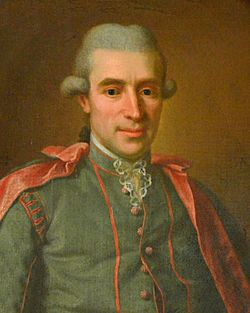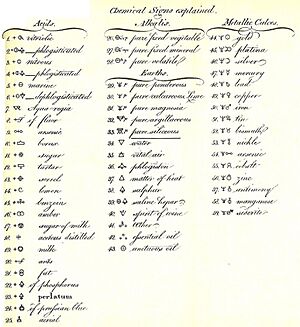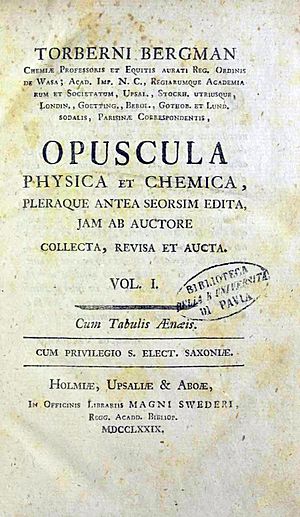Torbern Bergman facts for kids
Quick facts for kids
Torbern Bergman
|
|
|---|---|

Portrait by Ulrika Pasch
|
|
| Born |
Torbern Olaf Bergman
20 March 1735 Katrineberg, Låstad parish, Sweden
|
| Died | 8 July 1784 (aged 49) Medevi, Sweden
|
| Nationality | Swedish |
| Alma mater | University of Uppsala |
| Known for | Chemical affinity tables |
| Spouse(s) | Margareta Catharina Trast |
| Scientific career | |
| Fields | Chemist and mineralogist |
| Institutions | University of Uppsala |
| Doctoral advisor | Bengt Ferrner |
| Doctoral students | Johann Afzelius |
| Influences | Carl von Linné |
Torbern Bergman (born March 20, 1735 – died July 8, 1784) was a famous Swedish chemist and mineralogist. He is best known for his work on chemical affinity. This is the way different chemicals are attracted to each other.
In 1775, he published a book called Dissertation on Elective Attractions. This book contained the biggest tables of chemical attractions ever made. Bergman was also the first chemist to use a simple A, B, C system to name different chemical substances.
Contents
Early Life and Education
Torbern Bergman was born in Sweden on March 20, 1735. His parents were Barthold Bergman and Sara Hägg. When he was 17, he started studying at the University of Uppsala.
His father wanted him to study law or religion. But Torbern really wanted to learn about mathematics and natural science. He worked very hard to try and do both. This made him sick for a while.
During his break from studies, he enjoyed looking at plants and insects. He even found new types of insects. He sent them to the famous scientist Carl Linnaeus. In 1756, Torbern proved that a certain "water bug" was actually the egg of a type of leech. He went back to the university in 1758 and earned his PhD.
Becoming a Professor of Chemistry
After finishing his studies, Bergman taught physics and mathematics at the University of Uppsala. He wrote papers about interesting natural events. These included the rainbow, the Northern Lights, and the electric properties of a stone called tourmaline.
Later, the chemistry professor, Johan Gottschalk Wallerius, retired. Bergman wanted to take his place as a professor of chemistry and mineralogy. Some people said he didn't know enough about chemistry. This was because he hadn't written much about it yet.
To prove them wrong, he spent time in a lab. He wrote an important book about how to make alum. This book became a standard guide. With help from Gustav III, who was the crown prince, Bergman became the chemistry professor. He kept this job for the rest of his life.
Key Contributions to Science
Torbern Bergman made many important discoveries in chemistry. He greatly improved how scientists perform quantitative analysis. This is a way to measure the exact amounts of different substances in a sample.
He also created a new way to classify minerals. His system was based on their chemical properties and how they looked. He was known for his research on metals. He studied metals like bismuth and nickel in detail.
In 1764, Bergman became a member of the Royal Swedish Academy of Sciences. He was also elected to other important science groups. These included the Royal Society of London and the American Philosophical Society.
In 1771, Bergman found a way to make carbonated water. He did this by mixing chalk with sulphuric acid. He also helped another great chemist, Carl Wilhelm Scheele. Many people say that Scheele was Bergman's "greatest discovery." Bergman's book, Physical and Chemical Essays, was translated into English. It became a very important guide for chemical analysis.
Personal Life
In 1771, Torbern Bergman married Margareta Catharina Trast.
Legacy and Recognition
Torbern Bergman's work was so important that he has been honored in several ways. A uranium mineral was named after him, called torbernite. There is also a crater on the Moon named "Bergman" in his honor.
Works
- Tekniska Museet
See also
 In Spanish: Torbern Olof Bergman para niños
In Spanish: Torbern Olof Bergman para niños



